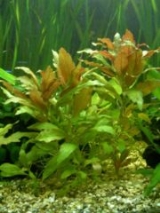
Alternanthera sessilis
Encyclopedia
Alternanthera sessilis is an aquatic plant
known by several common names, including sessile joyweed and dwarf copperleaf. It is used as an aquarium
plant.
The plant occurs around the world.
The leaves are used as a vegetable. Young shoots and leaves are eaten as a vegetable in Southeast Asia. Occasionally it is cultivated for food or for use in herbal medicines.
This species is classified as a weed
in parts of the southern States of the USA. It is usually (but not always especially in areas of high humidity where it can even be a garden weed
) found in wet or damp spots.
This is a perennial herb with prostrate stems, rarely ascending, often rooting at the nodes. Leaves obovate to broadly elliptic, occasionally linear-lanceolate, 1-15 cm long, 0.3-3 cm wide, glabrous to sparsely villous, petioles 1-5 mm long. Flowers in sessile spikes, bract and bracteoles shiny white, 0.7-1.5 mm long, glabrous; sepals equal, 2.5-3 mm long, outer ones 1-nerved or indistinctly 3-nerved toward base; stamens 5, 2 sterile. In the wild it flowers from December till March.
Aerva lanata is often mistaken for Alternanthera sessilis, which is also of the Amaranthecea family, and looks similar. On careful observation you will notice that flowers of Alternanthera sessilis are situated over the stem and their shape is round. As its flowers look like the eyes of a fish, Alternanthera sessilis is called Matsyakshi, fisheyed. Other Indian names of this plant are Koypa (Marathi), Honganne (Kannada). Leaves along with the flowers and tender stems are used as vegetable in Karnataka. It is diuretic, tonic and cooling. Juice of this plant, deemed beneficial to eyes, is an ingredient in the making of medicinal hair oils and Kajal (kohl). The red variety of this plant is a common garden hedging plant, which is also used as a culinary vegetable.
This plant is available in the aquarium
trade though it will not grow submersed for anything but short periods. However it can be useful in the tropical pond or terrarium though needs restriction as it can grow and propagate quickly under good conditions.
Aquatic plant
Aquatic plants are plants that have adapted to living in aquatic environments. They are also referred to as hydrophytes or aquatic macrophytes. These plants require special adaptations for living submerged in water, or at the water's surface. Aquatic plants can only grow in water or in soil that is...
known by several common names, including sessile joyweed and dwarf copperleaf. It is used as an aquarium
Aquarium
An aquarium is a vivarium consisting of at least one transparent side in which water-dwelling plants or animals are kept. Fishkeepers use aquaria to keep fish, invertebrates, amphibians, marine mammals, turtles, and aquatic plants...
plant.
The plant occurs around the world.
The leaves are used as a vegetable. Young shoots and leaves are eaten as a vegetable in Southeast Asia. Occasionally it is cultivated for food or for use in herbal medicines.
This species is classified as a weed
Weed
A weed in a general sense is a plant that is considered by the user of the term to be a nuisance, and normally applied to unwanted plants in human-controlled settings, especially farm fields and gardens, but also lawns, parks, woods, and other areas. More specifically, the term is often used to...
in parts of the southern States of the USA. It is usually (but not always especially in areas of high humidity where it can even be a garden weed
Weed
A weed in a general sense is a plant that is considered by the user of the term to be a nuisance, and normally applied to unwanted plants in human-controlled settings, especially farm fields and gardens, but also lawns, parks, woods, and other areas. More specifically, the term is often used to...
) found in wet or damp spots.
This is a perennial herb with prostrate stems, rarely ascending, often rooting at the nodes. Leaves obovate to broadly elliptic, occasionally linear-lanceolate, 1-15 cm long, 0.3-3 cm wide, glabrous to sparsely villous, petioles 1-5 mm long. Flowers in sessile spikes, bract and bracteoles shiny white, 0.7-1.5 mm long, glabrous; sepals equal, 2.5-3 mm long, outer ones 1-nerved or indistinctly 3-nerved toward base; stamens 5, 2 sterile. In the wild it flowers from December till March.
Aerva lanata is often mistaken for Alternanthera sessilis, which is also of the Amaranthecea family, and looks similar. On careful observation you will notice that flowers of Alternanthera sessilis are situated over the stem and their shape is round. As its flowers look like the eyes of a fish, Alternanthera sessilis is called Matsyakshi, fisheyed. Other Indian names of this plant are Koypa (Marathi), Honganne (Kannada). Leaves along with the flowers and tender stems are used as vegetable in Karnataka. It is diuretic, tonic and cooling. Juice of this plant, deemed beneficial to eyes, is an ingredient in the making of medicinal hair oils and Kajal (kohl). The red variety of this plant is a common garden hedging plant, which is also used as a culinary vegetable.
This plant is available in the aquarium
Aquarium
An aquarium is a vivarium consisting of at least one transparent side in which water-dwelling plants or animals are kept. Fishkeepers use aquaria to keep fish, invertebrates, amphibians, marine mammals, turtles, and aquatic plants...
trade though it will not grow submersed for anything but short periods. However it can be useful in the tropical pond or terrarium though needs restriction as it can grow and propagate quickly under good conditions.

